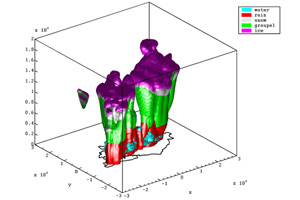Cloud Modelling Studies

Computer simulations are used in conjunction with field measurements and lab studies to further our understanding of cloud physics. A variety of different models are used operating at different resolutions, from the ability to resolve the detailed chemical and physics processes occuring in a single hill cap cloud to a highly parameterised represenation of cloud in a regional model or global circulation model. Current understanding of cloud processes can be tested in the models by comparing output from model runs initialised using real data with field observations. Models can also be used to test the sensivity of the modelled system to changes in the input parameters, and can evaluate the relative importance of individual mechanisms. Most major cloud physics studies have a significant modelling component, with modellers involved in planning the measurement studies to be undertaken to ensure an integrated approach.
Details of the models used within the Centre for Atmospheri Science to study clouds can be found here.
Some recent research projects involving modelling of cloud systems are: